Understanding Qualcomm's Snapdragon 810: Performance Preview
by Joshua Ho & Andrei Frumusanu on February 12, 2015 9:00 AM EST- Posted in
- SoCs
- Qualcomm
- Mobile
- Gobi
- Snapdragon 810
CPU/System Performance
While talking about the energy aware scheduler and various other aspects of the Snapdragon 810 is helpful to understand how the SoC works, ultimately we must look at performance to determine whether Qualcomm's work to differentiate their SoC was worthwhile or not. To do this, we ran Qualcomm's tablet Mobile Development Platform (MDP) through our standard suite of benchmarks, although I was unable to run benchmarks such as BaseMark X and PCMark due to odd issues with the tablet.
Starting off, we have a complete breakdown of GeekBench 3 scores. The scores are closer to theoretical performance than real-world performance, but it's very useful for highlighting architectural changes. For our look at GeekBench we are comparing the 810 reference platform to our results from our recent Galaxy Note 4 Exynos review, along with results for the Snapdragon 805-based Galaxy Note 4 taken from the GeekBench database.
| GeekBench 3 - Integer Performance | |||||||
| Snapdragon 805 (ARMv7) | Exynos 5433 (AArch32) | Snapdragon 810 (AArch64) | S810 > S805 % Advantage | ||||
| AES ST | 85.4 MB/s | 1330 MB/s | 604.9 MB/s | 608% | |||
| AES MT | 350.4 MB/s | 4260 MB/s | 3050MB/s | 770% | |||
| Twofish ST | 94.0 MB/s | 81.9 MB/s | 85.7 MB/s | -8.8% | |||
| Twofish MT | 329.8 MB/s | 440.5 MB/s | 448.5 MB/s | 36% | |||
| SHA1 ST | 202.1 MB/s | 464.2 MB/s | 428.1 MB/s | 112% | |||
| SHA1 MT | 806.1 MB/s | 2020 MB/s | 3019 MB/s | 275% | |||
| SHA2 ST | 95.1 MB/s | 121.9 MB/s | 81 MB/s | -15% | |||
| SHA2 MT | 367.3 MB/s | 528.3 MB/s | 393.4 MB/s | 7.1% | |||
| BZip2Comp ST | 4.46 MB/s | 4.88 MB/s | 4.99 MB/s | 12% | |||
| BZip2Comp MT | 15.5 MB/s | 19.3 MB/s | 20.5 MB/s | 32% | |||
| Bzip2Decomp ST | 6.43 MB/s | 7.41 MB/s | 7.99 MB/s | 24% | |||
| Bzip2Decomp MT | 21.7 MB/s | 29.7 MB/s | 30.8 MB/s | 42% | |||
| JPG Comp ST | 20.4 MPs | 19.3 MPs | 18.9 MP/s | -7.4% | |||
| JPG Comp MT | 79.9 MP/s | 88.8 MP/s | 88.9 MP/s | 11% | |||
| JPG Decomp ST | 30.6 MP/s | 43.5 MP/s | 36.3 MP/s | 19% | |||
| JPG Decomp MT | 115.7 MP/s | 149.6 MP/s | 182.7 MP/s | 58% | |||
| PNG Comp ST | 0.82 MP/s | 1.11 MP/s | 1.11 MP/s | 35% | |||
| PNG Comp MT | 3.01 MP/s | 4.57 MP/s | 4.78 MP/s | 59% | |||
| PNG Decomp ST | 18.7 MP/s | 19.1 MP/s | 15.6 MP/s | -17% | |||
| PNG Decomp MT | 63.7 MP/s | 78.8 MP/s | 94.1 MP/s | 48% | |||
| Sobel ST | 39.2 MP/s | 58.6 MP/s | 53.3 MP/s | 36% | |||
| Sobel MT | 128 MP/s | 221.3 MP/s | 248.4 MP/s | 94% | |||
| Lua ST | 0.92 MB/s | 1.24 MB/s | 1.30 MB/s | 41% | |||
| Lua MT | 1.36 MB/s | 2.48 MB/s | 5.93 MB/s | 336% | |||
| Dijkstra ST | 4.46 Mpairs/s | 5.23 Mpairs/s | 3.38 Mpairs/s | -24% | |||
| Dijkstra MT | 13.2 Mpairs/s | 17.1 Mpairs/s | 13.7 Mpairs/s | 3.8% | |||
Thanks in large part to the new cryptographical capabilities of the ARMv8 cores, Snapdragon 810 gets off to a very good start in GeekBench 3's integer benchmarks. Once we move on to the rest of our benchmarks, we find that 810 continues to hold a considerable advantage through most of these benchmarks; BZip2 decompression, Lua script performance, and JPEG decompression all show considerable performance gains over the Snapdragon 805 based Galaxy Note 4. Snapdragon 810's overall performance improvement here is a rather large 45%, though if we throw out the especially large gains that come from Lua MT, the overall performance advantage is closer to 30%.
There are a few cases where performance regresses however, including in PNG decompression and Dijkstra's algorithm. This could be a result of memory performance (more on that later) or architectural differences. It's worth pointing out that these cases are also among the only cases where Snapdragon 810 notably trails the Exynos 5433.
| GeekBench 3 - Floating Point Performance | |||||||
| Snapdragon 805 (ARMv7) | Exynos 5433 (AArch32) | Snapdragon 810 (AArch64) | S810 > S805 % Advantage |
||||
| BlackScholes ST | 4.33 Mnodes/s | 4.37 Mnodes/s | 5.01 Mnodes/s | 16% | |||
| BlackScholes MT | 17.0 Mnodes/s | 20.4 Mnodes/s | 25.5 Mnodes/s | 50% | |||
| Mandelbrot ST | 0.87 GFLOPS | 1.14 GFLOPS | 1.20 GFLOPS | 38% | |||
| Mandelbrot MT | 3.45 GFLOPS | 5.09 GFLOPS | 6.41 GFLOPS | 86% | |||
| Sharpen Filter ST | 886 MFLOPS | 1030 MFLOPS | 1007 MFLOPS | 14% | |||
| Sharpen Filter MT | 3.54 GFLOPS | 4.31 GFLOPS | 5.02 GFLOPS | 42% | |||
| Blur ST | 1.18 GFLOPS | 1.27 GFLOPS | 1.26 GFLOPS | 6.8% | |||
| Blur MT | 4.67 GFLOPS | 5.03 GFLOPS | 6.14 GFLOPS | 31% | |||
| SGEMM ST | 2.82 GFLOPS | 1.81 GFLOPS | 2.29 GFLOPS | -19% | |||
| SGEMM MT | 8.05 GFLOPS | 6.1 GFLOPS | 6.12 GFLOPS | -24% | |||
| DGEMM ST | 0.81 GFLOPS | 0.57 GFLOPS | 1.03 GFLOPS | 27% | |||
| DGEMM MT | 2.69 GFLOPS | 2.29 GFLOPS | 2.81 GFLOPS | 4.5% | |||
| SFFT ST | 1.16 GFLOPS | 1.1 GFLOPS | 1.25 GFLOPS | 7.8% | |||
| SFFT MT | 4.55 GFLOPS | 4.56 GFLOPS | 4.11 GFLOPS | -9.7% | |||
| DFFT ST | 0.47 GFLOPS | 1.02 GFLOPS | 1.03 GFLOPS | 119% | |||
| DFFT MT | 1.89 GFLOPS | 3.46 GFLOPS | 2.97 GFLOPS | 57% | |||
| N-Bod ST | 331.5 Kpairs/s | 370.4 Kpairs/s | 486.6 Kpairs/s | 47% | |||
| N-Bod MT | 1.12 Mpairs/s | 1.44 Mpairs/s | 1.72 Mpairs/s | 54% | |||
| Ray Trace ST | 1.48 MP/s | 1.7 MP/s | 1.73 MP/s | 17% | |||
| Ray Trace MT | 5.77 MP/s | 6.65 MP/s | 8.16 MP/s | 41% | |||
GeekBench's floating point performance shows a similar range of performance increases. More often than not multi-threaded performance gains exceed single-threaded performance gains, which is a hopeful sign for how well the Snapdragon 810 reference platform can hold up when all four big cores are being hammered. Otherwise the 810 shows considerable performance gains on almost every benchmark here, the sole exception being SGEMM performance.
In this case Snapdragon 810 performance is relatively close to Exynos 5433 performance even though it has the advantage of running in AArch64 mode, which should give the FP numbers a boost over the Exynos. The SGEMM test is likely an isolated case where the Krait architecture and Snapdragon 805's high clock speed play to its favor. The overall Snapdragon 810 performance improvement is 30%, almost exactly what we saw with GeekBench integer performance as well (after throwing out Lua MT).
| GeekBench 3 - Memory Performance | ||||||
| Snapdragon 805 (ARMv7) | Exynos 5433 (AArch32) | Snapdragon 810 (AArch64) | S810 > S805 % Advantage |
|||
| Stream Copy ST | 8.37 GB/s | 5.56 GB/s | 6.02 GB/s | -28% | ||
| Stream Copy MT | 10.2 GB/s | 5.80 GB/s | 7.57 GB/s | -26% | ||
| Stream Scale ST | 5.17 GB/s | 4.98 GB/s | 6.61 GB/s | 28% | ||
| Stream Scale MT | 8.05 GB/s | 5.77 GB/s | 7.37 GB/s | -8.4% | ||
| Stream Add ST | 5.06 GB/s | 4.85 GB/s | 5.64 GB/s | 11% | ||
| Stream Add MT | 7.46 GB/s | 5.72 GB/s | 6.62 GB/s | -11% | ||
| Stream Triad ST | 5.37 GB/s | 4.82 GB/s | 5.6 GB/s | 4.3% | ||
| Stream Triad MT | 8.20 GB/s | 5.73 GB/s | 6.63 GB/s | -19% | ||
Usually we don't like to post the GeekBench memory scores, but in this case there is an interesting phenomenon going on with the Snapdragon 810. Although the LPDDR4 memory running at 1555MHz gives the SoC a large advantage in memory bandwidth over the Exynos 5433 and runs its CCI at 787 MHz, giving the CPU port a theoretical 12.6 GB/s that's much more than the 6.6GB/s of the 5433, the actual measured bandwidth difference is much less and is nowhere near that figure in any of the sub-tests.
To look at this in more detail, we use AndEBench's memory benchmarks, and indeed we see a similar result.
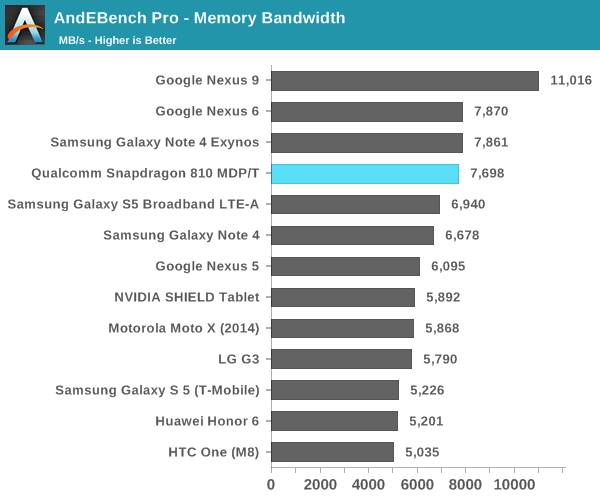
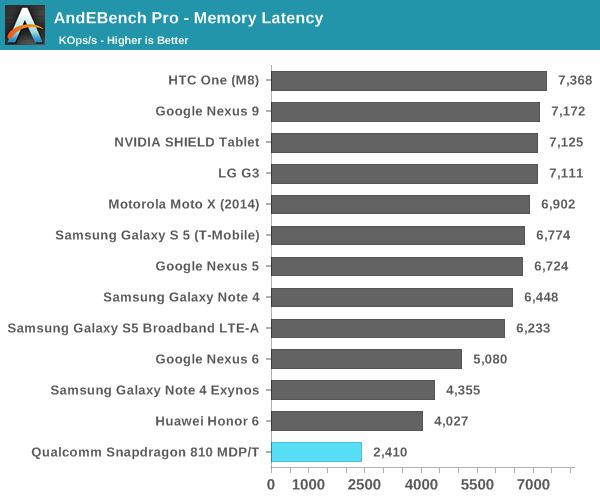
It's the memory latency test in particular that's very worrisome, as the MDP tablet achieves a very bad throughput score. We're not sure why this happens, but we hope to investigate this further in the future when we get the chance to review a shipping Snapdragon 810 device.
Continuing on, let's look at our browser bench suite.
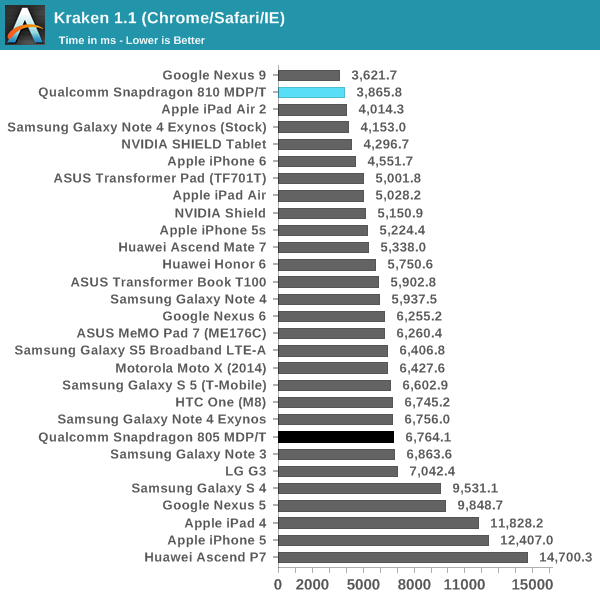
Here, the Snapdragon 810 is off to quite a start. While not a direct correlation, performance in these benchmarks can generally be correlated with CPU performance. The Snapdragon 810 shines here and approaches the Nexus 9, which has a strong showing due to the underlying Denver CPU's code optimizer unrolling loops in the benchmark.
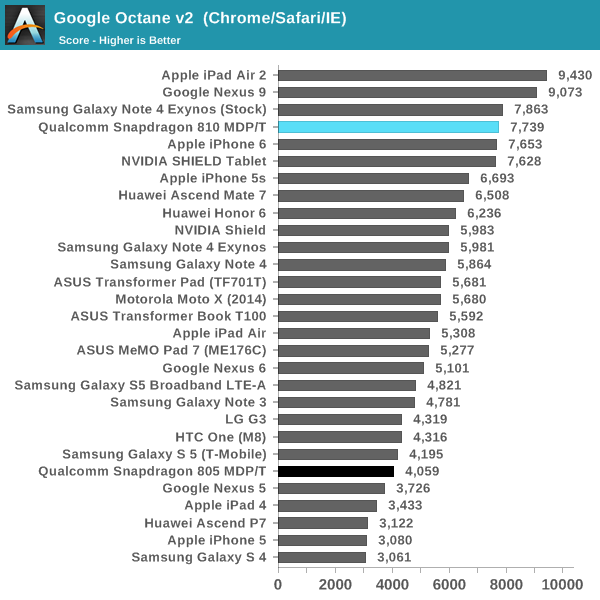
In Octane, we see that the Snapdragon 810 continues to be competitive with some of the fastest SoCs available today.
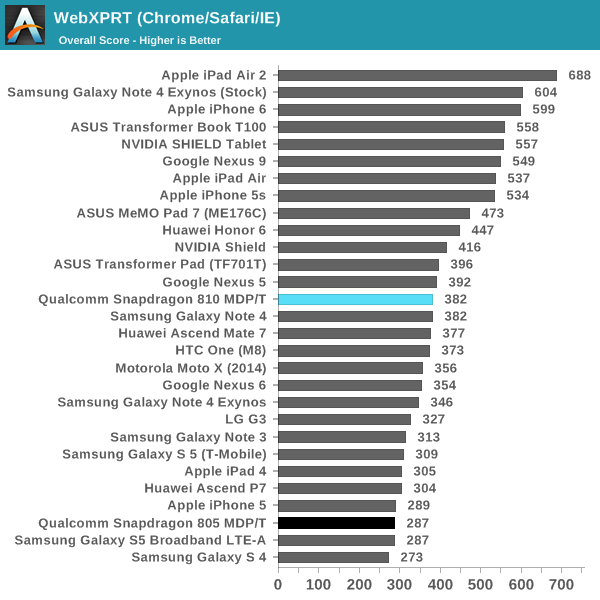
On the other hand, in WebXPRT we see that performance ends up somewhere around the level of the Snapdragon 801. It's possible that we're looking at thermal throttling or some other issue here as I was unable to run multiple trials of this test. Our browser based tests are otherwise generally consistent with what we found earlier this week on the A57-based Exynos 5433, so it's unlikely we're looking at an unoptimized Chrome build.
Continuing with the benchmarks we were able to perform at the performance preview, BaseMark OS II is next.
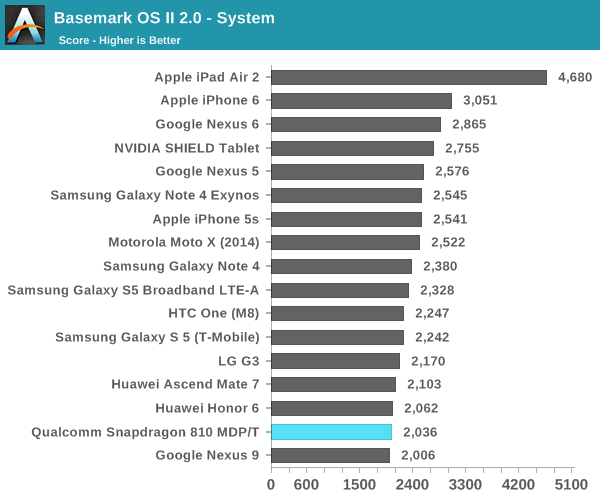
The System numbers of the Snapdragon 810 MDP/T seem disappointing, as it falls at the lower end of our current flagship device lineup. It seems the reference platform isn't as well optimized as it should be.
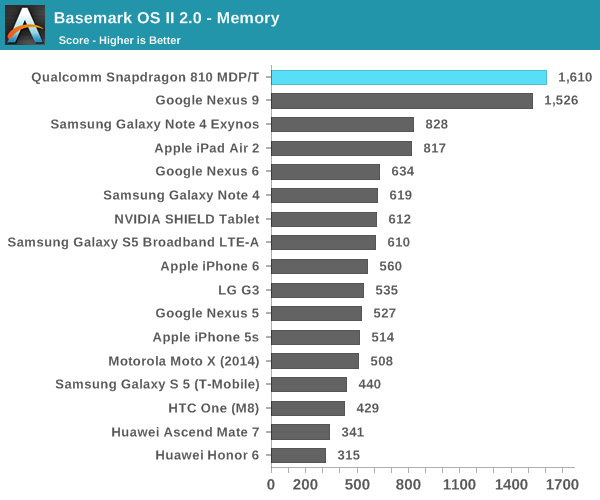
Similar to the Nexus 9, we see some odd trends in the memory tests. It isn't quite clear what's causing this, but a performant eMMC is certainly a possibility. Due to this test being very device specific, we can't really judge the Snapdragon 810's performance here.
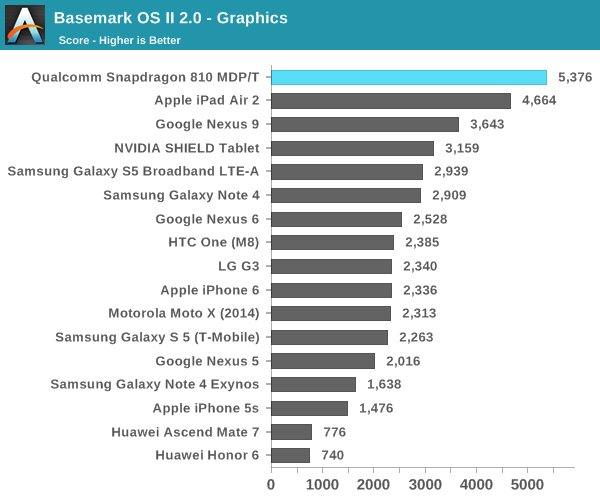
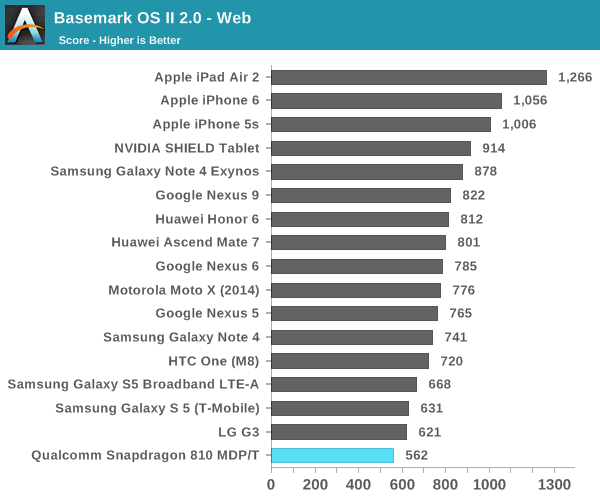
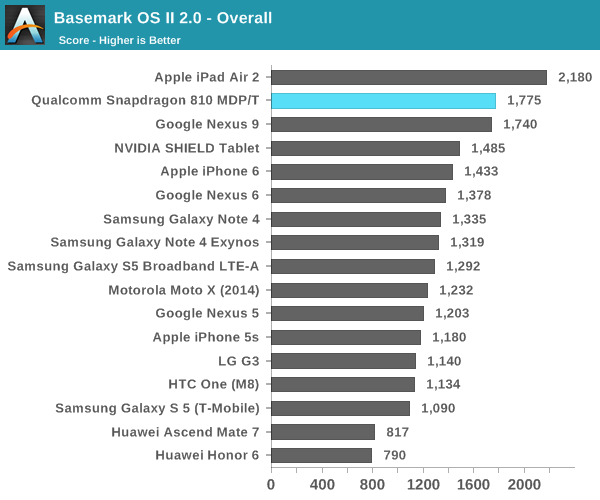
As for BaseMark, what we get are very binary results with the 810 either coming in near the top or bottom. The overall score still looks quite good as a result, boosted by things such as chart-topping graphics performance. On the other hand the web and system scores are struggling, coming in 20% or more behind the Note 4 and it's A57 based Exynos 5433. Since this is an early device this may be a case of early teething issues with performance, possibly with optimizations or the OS, but at this point in time it's difficult to confirm anything.
Meanwhile looking at how Qualcomm's reference platform compares to the Snapdragon 805-based Nexus 6, we find some significant performance gains at times. Though Krait has held up admirably against its A15 based competition, A57 finally provides a solid jump in performance over what even the fastest Krait can offer.










119 Comments
View All Comments
PC Perv - Saturday, February 14, 2015 - link
Not an accurate description of the state of affairs. It is because Apple has the power over the carriers that other OEMs lack. I wish Congress can intervene in the situation and rein in on the carriers. That will not only benefit the U.S. consumers but also potentially influence the world market.Absolutely not "because Apple spend more money and Android OEMs do not want to spend money"
name99 - Friday, February 13, 2015 - link
"While there are multiple solutions to solving the power problem that comes with OoOE, ARM currently sees big.LITTLE as the best solution. "I can't help but think (based on all the evidence we've seen so far) that big.LITTLE is the VLIW of low energy CPUs. Just like VLIW would be totally awesome if we could only solve those pesky compiler issues (which are just out of reach, but maybe next year...), so big.LITTLE would be awesome if we could only solve those pesky scheduler issues (which will, likewise, maybe be solved next year...)
It's nice that QC claim they have a better scheduler; it would be even nicer if they were confident enough about it to provide actual power/energy NUMBERS...
TT Masterzz - Sunday, February 15, 2015 - link
Amazing article. Although to be frank I hardly understood the antenna part. It would be amazing if the authors at Anand Tech make an article explaining the RF system/modems/naming scheme and baseband processors in depth. Also an article explaining some terms like CPU pipeline length/branch mispredict would be amazing.Laststop311 - Friday, February 20, 2015 - link
All this is telling me is that it can barely beat last generation exynos. The exynos 7 most likely stomps this in performance which is why samsung had to go qwith it for all countries. People would be too mad if only S Korea got the super fast exynos 7 and every 1 else got the slower 810. Before snapdragon had the slioght performance edge but looks like exynos may finally be the better chip.That is untile qualcomm busts out their custom made 64 bit krait that just wasnt ready in time so they had to use standard arm cores to get 64 bit to market faster. Custom Kraint 64 whatever they call it it krait 500 or something will most likely beat exynos again.
Zingam - Wednesday, February 25, 2015 - link
Will these be DX12, OpenGL Next compatible, or will we have to wait for another 5 years for sufficient market penetration.Keermalec - Saturday, March 21, 2015 - link
So The 1-year old Nvidia K1 trounces the yet to arrive snapdragon 810...And yes, LTE is not integrated into the K1 in order for OEMS to have a choice between wifi or wifi+LTE tablet versions. Nvidia CAN integrate LTE in the SoC as they have done with the Tegra 4i. It was just sound business practice not to do so with the more powerful chip.
radeonex - Saturday, April 11, 2015 - link
I want to point out that for linear amplifier circuits, most of the transistors operation in the saturated region (they do not act as switches but rather voltage controlled current sources). The high electron mobility helps with trans-conductance and other characteristics especially in the context of combating short-channel effects (helps smaller devices). It also helps to reduce the minimum voltage drop required to keep the saturated transistors in the correct region of operation.Ning3n - Monday, July 27, 2015 - link
To give a "joe sixpack" review of the 810. I recently replaced my HTC M7 with an M9....As far as I've seen/noticed, the 810 (combined with the 430 GPU), is *ROUGHLY* 15-20% faster than the 600 series I've upgraded from.
Gaming performance (for a cellular device) is great! But, it took over an hour to encrypt just under 5Gb of mp3s, and 1.5Gb of pictures.
Hardly a "phenomenal" improvement.
b.akhil96 - Tuesday, June 21, 2016 - link
How do you categorize the loads ? max(avg,recent) policy when loads are categorized as peak or non peak . what would be an ideal policy to be applied on Moderate loads. (similar to max(avg,recent) )